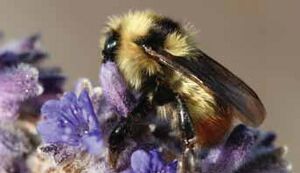Central bumblebee facts for kids
Quick facts for kids Central bumblebee |
|
|---|---|
 |
|
| Queen | |
| Conservation status | |
| Scientific classification | |
| Genus: |
Bombus
|
| Species: |
centralis
|
The central bumblebee (Bombus centralis) is a type of bumble bee. You can find these bees in parts of Canada and the western United States. A scientist named Ezra Townsend Cresson first described this species in 1864.
What Does the Central Bumblebee Look Like?
The central bumblebee is a small bee. It has a long face and a long tongue, called a proboscis. Its wings are a light brown color.
The size of these bees depends on if they are a queen, male, or worker:
- A queen bee is about 12.5 to 16 millimeters (about half an inch) long. Her wings can spread 29 to 33 millimeters wide.
- Male bees are a bit smaller, from 10 to 13 millimeters long. Their wings spread 22 to 29 millimeters wide.
- Worker bees are the smallest, measuring 9.5 to 12.5 millimeters long. Their wings spread 23 to 28 millimeters wide.
The top part of their body, called the thorax, is yellow. The front part of their belly, or abdomen, is also yellow. The middle sections of their belly (segments 3 and 4 for females, and 3 to 5 for males) are orange-red. The very end of their body, their "tail," is black. These bees have long hair all over their bodies. They also have a black stripe across the middle of their thorax.
Where Do Central Bumblebees Live?
You can find central bumblebees in many places. In Canada, they live in British Columbia and Alberta. In the United States, they are found in California, Arizona, and New Mexico.
How Do Central Bumblebees Live?
These bumblebees like to live in open grasslands, called prairies. They also live in river valleys.
The queen bees spend the winter sleeping. They wake up in late May. Then, they start building a new nest. They often choose old nests that rodents no longer use. About a month later, the first worker bees hatch. The nest starts to get smaller in September. By then, all the bees, except for the new queens, die. The new queens will then find a place to sleep for the winter.
Central bumblebees visit many different kinds of flowers to find food. They collect nectar and pollen from plants like wild onions, rabbitbrush, thistles, goldenbushes, coyote mints, penstemons, and phacelias.


